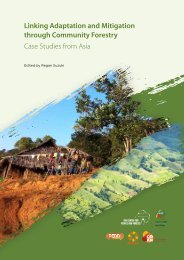Desktop Study on - Regional Climate Change Adaptation ...
Desktop Study on - Regional Climate Change Adaptation ...
Desktop Study on - Regional Climate Change Adaptation ...
You also want an ePaper? Increase the reach of your titles
YUMPU automatically turns print PDFs into web optimized ePapers that Google loves.
Assessment of Capacity Gaps and Needs of South East Asia Countries<br />
in Addressing Impacts, Vulnerability and Adaptati<strong>on</strong> to <strong>Climate</strong> Variability and <strong>Climate</strong> <strong>Change</strong><br />
“What is needed is a framework for managing<br />
water resources in a sustainable manner with<br />
climate change mitigati<strong>on</strong> and adaptati<strong>on</strong> measures<br />
embedded in it”, and its goals should be equity<br />
distributi<strong>on</strong> of water between the sectors, clean<br />
and vibrant rivers and water bodies, Malaysia’s<br />
biodiversity recognized, protected, thriving and<br />
c<strong>on</strong>tributing to the country’s ec<strong>on</strong>omy, floods,<br />
erosi<strong>on</strong>, landslides and other land & water related<br />
challenges (including due to climate change), well<br />
managed and under c<strong>on</strong>trol; all to reach a Water<br />
Resources Management fully integrated throughout<br />
the country (Zakaria and Jamalluddin, 2007).<br />
In agriculture, the third Nati<strong>on</strong>al Agricultural policy<br />
makes no references to the climate change threat<br />
and to the necessity of adaptati<strong>on</strong>. Regarding rice<br />
crops, drought and flood resistant varieties need<br />
to be introduced. There is a need to generate crop<br />
varieties with improved water-use efficiency suited<br />
to producti<strong>on</strong> with reduced water inputs (Abdullah,<br />
2008). There are still some uncertainties like the<br />
magnitude of the change, the technology available,<br />
the crop and pest resp<strong>on</strong>ses, what the adaptati<strong>on</strong><br />
measures are, lack of policies, and lack of methods of<br />
assessment (Abdullah, 2008).<br />
As for socio ec<strong>on</strong>omic aspects, the adaptati<strong>on</strong><br />
measures are feasible in the Malaysian c<strong>on</strong>text, but<br />
additi<strong>on</strong>al efforts are needed to quantify them in<br />
terms of cost implicati<strong>on</strong>s. Some of these additi<strong>on</strong>al<br />
efforts include further research and development in<br />
improving the science of predicti<strong>on</strong> of the resp<strong>on</strong>ses<br />
and quantitative bases for estimating impacts and<br />
ec<strong>on</strong>omic costs (MOSTE, 2000).<br />
There is a need to refine the methodology of costing<br />
socio-ec<strong>on</strong>omic impacts through more research as<br />
well as to establish a disaster impact inventory. In<br />
additi<strong>on</strong>, it is necessary to develop and incorporate<br />
ec<strong>on</strong>omic recovery plans in dealing with disasters.<br />
There is also a need to study n<strong>on</strong>-communicable<br />
diseases that may result from changes in the<br />
climate scenario such as increased stress within<br />
residents of small houses or flats as a result of rising<br />
temperatures. The management of energy, water<br />
and land resources need to be planned to balance<br />
demand and supply with adequate emphasis <strong>on</strong> the<br />
management of c<strong>on</strong>sumpti<strong>on</strong>. More acti<strong>on</strong> should be<br />
taken towards providing more informati<strong>on</strong> to policy<br />
makers to promote informati<strong>on</strong>-based decisi<strong>on</strong>making<br />
(MOSTI, 2007).<br />
The c<strong>on</strong>vergence of disaster and climate change<br />
management should be mainstreamed into nati<strong>on</strong>al<br />
policies, programmes and plans as both are crosssectoral<br />
issues. Although the instituti<strong>on</strong>al capacity<br />
in the country is capable of managing disasters,<br />
there is still much room for improvement. The<br />
existing mechanism for stakeholder c<strong>on</strong>sultati<strong>on</strong> is<br />
insufficient and requires enhancement as it is both<br />
the resp<strong>on</strong>sibility of government and the community<br />
in dealing with issues pertaining to disasters. In<br />
additi<strong>on</strong>, current sectoral approaches need to be<br />
changed, with reference to the Hyogo Framework<br />
Acti<strong>on</strong>, which emphasises mainstreaming disaster<br />
management into planning (MOSTI, 2007).<br />
153

















